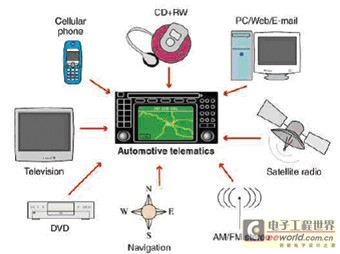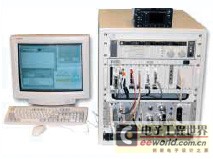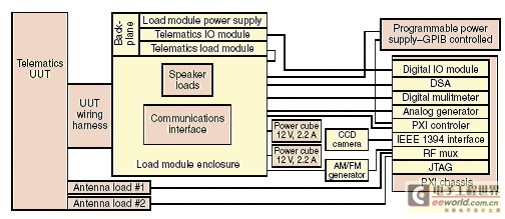Nowadays, many new technologies have emerged in the automotive information system, which is an indisputable fact for manufacturers. Many cars already include navigation, CD, AM/FM, DVD and cellular phone functions – and digital video recorders, eco-ignition devices and remote diagnostic devices are emerging. Once these new features are adopted, this greatly increases the task of testing because functional testing is required to be proportional to the functionality being tested.
Modular and software-based test methods leverage the PC architecture to extend or shrink the capabilities of the test to meet these test challenges. I will analyze some of the key elements of ICT design and then give a few examples of testing these information devices (Figure 1).

Figure 1 With the introduction of new technologies in automotive systems, the complexity of information and communication testing has also increased.
Design more features faster with fewer devices
Why the demand for car information equipment has grown so fast, the answer is obvious – users want to have the same comfortable and safe lifestyle as they do on the road. But how do designers make new technologies come true? How do designers use these new technologies? An important reason for achieving these modern information systems is the advancement of semiconductor packaging technology. The large-volume dual in-line package (approximately 175 mm2) has been replaced by a small ball grid array device (approximately 1.34 mm2), which greatly reduces the surface area for the same process. This trend of continual adoption of new packaging technologies will reduce the overall space required for new or new technologies, while also increasing the amount of inspection required at the time of manufacture.
Not only is the size of the chip constantly decreasing, but its function is also constantly improving. It is now common to integrate devices that receive AM, FM or digital radio functions in a single chip. In cellular technology, a single chip such as Silicon Valley's Aero can be a two- or three-band GSM transceiver with a small number of devices. The size of the chip used to be the limiting factor for multi-band communication, and now this is no longer a problem, and other features such as video can be added. Since the integrated performance of a single chip provides additional space, it makes it easy to add new features to the information system in the future.
The role of software
The amount of software used in electronic devices has also increased dramatically. With the advancement of microprocessor technology, it now executes 10,000 times per second of instructions 20 years ago, allowing software to handle many tasks that previously required completely separate hardware. A compelling example is the software radio. Designing a hardware device that can accept all wireless communication protocols will have tremendous market potential. The military has already achieved this in the Joint TacTIcal Radio System (JTRS) and will certainly be extended to commercial equipment in the near future. In terms of information communication, car buyers will not need to add information control boxes to the car, but will increase the information function by using software loaded on the console.
It is important to realize that the time pressure of time to market has a huge impact on design and testing. Powerful electronic design automaTIon (EDA) software can make boards do not need to be redesigned in some cases. When the speed in the design phase is increased, the other stages of development are also required to increase the speed. As smaller hardware devices, repeatable hardware, and electronic design emerge faster than ever, a PC-based, software-centric, modular platform approach can keep up with this trend.

Figure 2 The Mindready automotive multimedia and information communication ATE system can handle simple verification applications.
ATE for information communication
Consider the software-based features mentioned above. If a car dealer wants to add 10 different functions to the information system during the use of the car, it is necessary to perform functional tests in production to verify that these functions are working properly, and that they can be implemented in different orders, or The inspection is completed when the information system has other functions. In essence, the number of tests will increase exponentially, and engineers are under pressure to minimize test time and costs. To solve these problems, NI's system integrator, Mindready SoluTIons (www.mindready.com), developed the Mindready automotive multimedia and information communication ATE system. The company's Tier 1 automotive customers need an upgradeable platform that can perform simple AM/FM testing from start to finish for complex display, GPS, DVD and satellite applications. Customers need the system to be flexible enough to fit all automotive platforms and add new features to future models. They are looking for scalable equipment for use in design, verification, durability testing and manufacturing to eliminate hardware and software discontinuities in these processes.
The Mindready system is based on NI's TestStand test management software, which provides Mindready customers with an open architecture to customize the system – either as part of an extended validation and verification phase or as an end detector. When the good test code is written to verify the system and set the specification boundaries, the device can also be functionally tested using the same hardware. Features such as auto-arrangement and parallel testing in TestStand can be used to meet the software's custom features—the sorted and combined features can be easily reused through the software's test framework.
The TestStand program runs on an embedded PXI controller. PXI is an industry-standard, PC-based platform that enables a wide range of measurements. In this case, video, audio, digital, analog, and RF can be tested at a range of powers and frequencies. When information systems have evolved to require mixed-signal testing, PXI offers a modular instrumentation platform that fully integrates timing and triggering and leverages the latest commercialization technologies (Figure 3).

Figure 3. The TestStand software running on the PXI controller in the Mindready system can schedule the tests in sequence. For simple DC voltage, DC current and resistance measurements, the Mindready system includes a digital multimeter. NI 4-GHz RF Multiplexer - The PXI-2591 provides multi-antenna interface switches from an external RF generator to a test unit (UUT).
For simple DC voltage, DC current and resistance measurements, the Mindready system includes a digital multimeter. NI 4GHz RF Multiplexer - The PXI-2591 provides multi-antenna interface switches from an external RF generator to a test unit (UUT). Using high-density switches in PXI increases the test points of the system. The included IEEE 1394 interface module can also capture images from cameras in video tests or extend them for future applications.
All of these components enable the system to provide the functionality required by the test environment and the hardware or software required to test the environment.
Dashboard test
Another solution to information testing came from Altec Visteon in Chihuahua, Mexico. The company needed a flexible, rather than a single, test solution for testing radios and dashboards. Like Mindready Systems, Altec Visteon chose the PXI platform for testing and switching functions; the company uses LabWindows/CVI and TestStand as programming tools and test management software.
Radio test content includes audio quality, tone, frequency, clock, and other display information. Altec Visteon uses an eight-channel PXI dynamic signal acquisition module for most tests. PXI enables Visteon to test standard stereo in two channels or by adding channels to form a more complex sound system. Pre-defined software algorithms allow the system to test output distortion, frequency response, and signal-to-noise ratio. The company uses PXI image acquisition modules to test the display of dashboards and radios.
At the same time, Visteon test equipment can be extended to meet future test requirements. Software and PXI platforms add new test functions and code modules when adding satellite wireless communications, Bluetooth and holographic displays. By using a PC to control the system and using modular hardware for measurements, the system meets Visteon's requirements for scalability and flexibility.
future development
The challenges facing the automotive industry in the last decade show that future systems require more testing capabilities. As the consumer electronics market continues to redefine multimedia standards, things that have been of concern to everyone will soon be replaced by new hotspots. A flexible and scalable, software-based measurement and automation platform – this is a great way to increase functionality and reduce time-to-market. funcTIon ImgZoom(Id)//Reset the image size to prevent breaking the table { var w = $(Id).width; var m = 650; if(w < m){return;} else{ var h = $(Id) .height; $(Id).height = parseInt(h*m/w); $(Id).width = m; } } window.onload = function() { var Imgs = $("content").getElementsByTagName( "img"); var i=0; for(;i
Electric Bicycle Battery,24V Ebike Battery Series,24V Cylinder Lithium Battery,Deep Cycle Lithium Battery
ZHEJIANG TIANHONG LITHIUM-ION BATTERY CO.,LTD , http://www.tflbattery.com